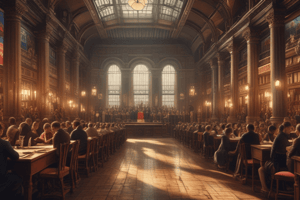Podcast
Questions and Answers
What is a primary source in history?
What is a primary source in history?
- A history book written by a scholar
- A museum exhibit about a historical era
- A documentary film about a historical event
- A letter written by a person from the time period being studied (correct)
What is the purpose of evaluating history sources?
What is the purpose of evaluating history sources?
- To identify the type of source
- To determine the author's qualifications
- To understand the historical event or era
- To determine the reliability and accuracy of the information (correct)
What is an example of a secondary source?
What is an example of a secondary source?
- A government record from the 18th century
- A diary from the 19th century
- A photograph from the 20th century
- A history book written by a scholar (correct)
What is the criteria for evaluating the authority of a history source?
What is the criteria for evaluating the authority of a history source?
What is the purpose of analyzing multiple sources?
What is the purpose of analyzing multiple sources?
What is the purpose of using quotes or excerpts from history sources?
What is the purpose of using quotes or excerpts from history sources?
Why is it important to consider the bias of a history source?
Why is it important to consider the bias of a history source?
What is the purpose of citing sources in history?
What is the purpose of citing sources in history?
What is an example of a primary source that is visual?
What is an example of a primary source that is visual?
What is the purpose of asking questions when evaluating history sources?
What is the purpose of asking questions when evaluating history sources?
Flashcards are hidden until you start studying
Study Notes
Types of History Sources
Primary Sources
- Original materials from the time period being studied
- Examples:
- Diaries, letters, and other personal documents
- Government records, laws, and official documents
- Newspapers, magazines, and other media from the time
- Photographs, videos, and other visual materials
- Artifacts, objects, and oral histories
Secondary Sources
- Interpretations and analyses of primary sources
- Examples:
- History books, articles, and academic papers
- Documentaries and films about historical events
- Museum exhibits and displays
- Online resources and educational websites
Evaluating History Sources
Criteria for Evaluation
- Authority: Who is the author? What are their qualifications?
- Purpose: Why was the source created? What is its intention?
- Bias: Is the source objective or does it present a particular perspective?
- Reliability: Is the information accurate and trustworthy?
- Relevance: Is the source relevant to the topic being studied?
Questions to Ask When Evaluating Sources
- Who is the intended audience?
- What is the tone and language used?
- Are there any limitations or gaps in the information?
- Can the information be verified through other sources?
- Is the source peer-reviewed or has it been critiqued by others?
Working with History Sources
Analyzing Sources
- Identify the type of source (primary or secondary)
- Evaluate the source using the criteria above
- Consider multiple sources to get a more complete understanding
- Look for patterns, themes, and relationships between sources
Using Sources Effectively
- Use quotes or excerpts to support arguments or claims
- Paraphrase or summarize information to put it in your own words
- Avoid plagiarism by properly citing sources
- Use sources to support your own analysis and interpretation
Types of History Sources
- There are two main types of history sources: primary and secondary sources
Primary Sources
- Original materials from the time period being studied
- Examples include:
- Diaries, letters, and other personal documents that provide firsthand information
- Government records, laws, and official documents that offer official views
- Newspapers, magazines, and other media from the time that provide contemporary views
- Photographs, videos, and other visual materials that provide visual evidence
- Artifacts, objects, and oral histories that offer tangible and intangible evidence
Secondary Sources
- Interpretations and analyses of primary sources
- Examples include:
- History books, articles, and academic papers that interpret and analyze primary sources
- Documentaries and films about historical events that provide an interpreted view
- Museum exhibits and displays that showcase and interpret artifacts and objects
- Online resources and educational websites that provide an interpreted view
Evaluating History Sources
Criteria for Evaluation
- Authority: The credibility and qualifications of the author
- Purpose: The reason why the source was created and its intended use
- Bias: The presence of a particular perspective or agenda
- Reliability: The accuracy and trustworthiness of the information
- Relevance: The relevance of the source to the topic being studied
Questions to Ask When Evaluating Sources
- Who is the intended audience of the source?
- What is the tone and language used in the source?
- Are there any limitations or gaps in the information provided?
- Can the information be verified through other sources?
- Is the source peer-reviewed or has it been critiqued by others?
Working with History Sources
Analyzing Sources
- Identify the type of source (primary or secondary)
- Evaluate the source using the criteria above
- Consider multiple sources to get a more complete understanding
- Look for patterns, themes, and relationships between sources
Using Sources Effectively
- Use quotes or excerpts to support arguments or claims
- Paraphrase or summarize information to put it in your own words
- Avoid plagiarism by properly citing sources
- Use sources to support your own analysis and interpretation
Studying That Suits You
Use AI to generate personalized quizzes and flashcards to suit your learning preferences.




